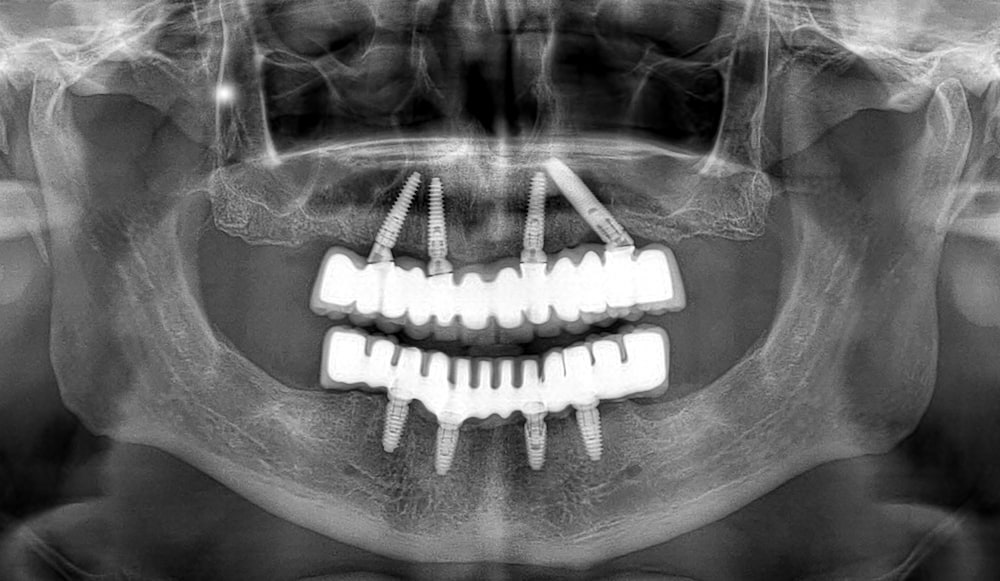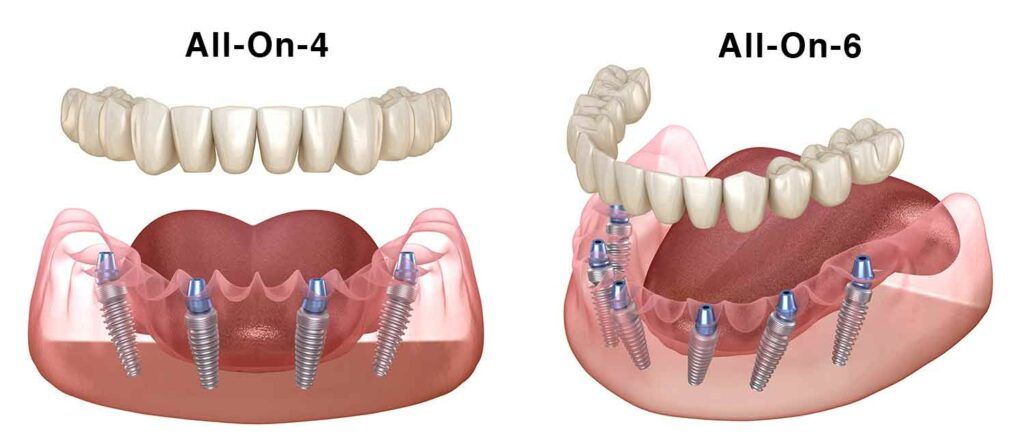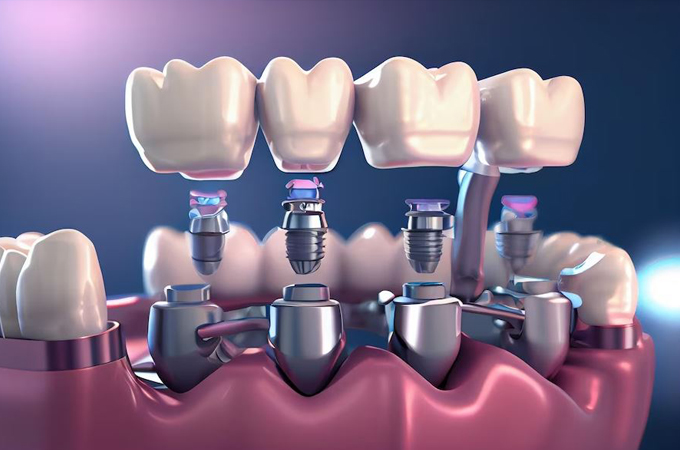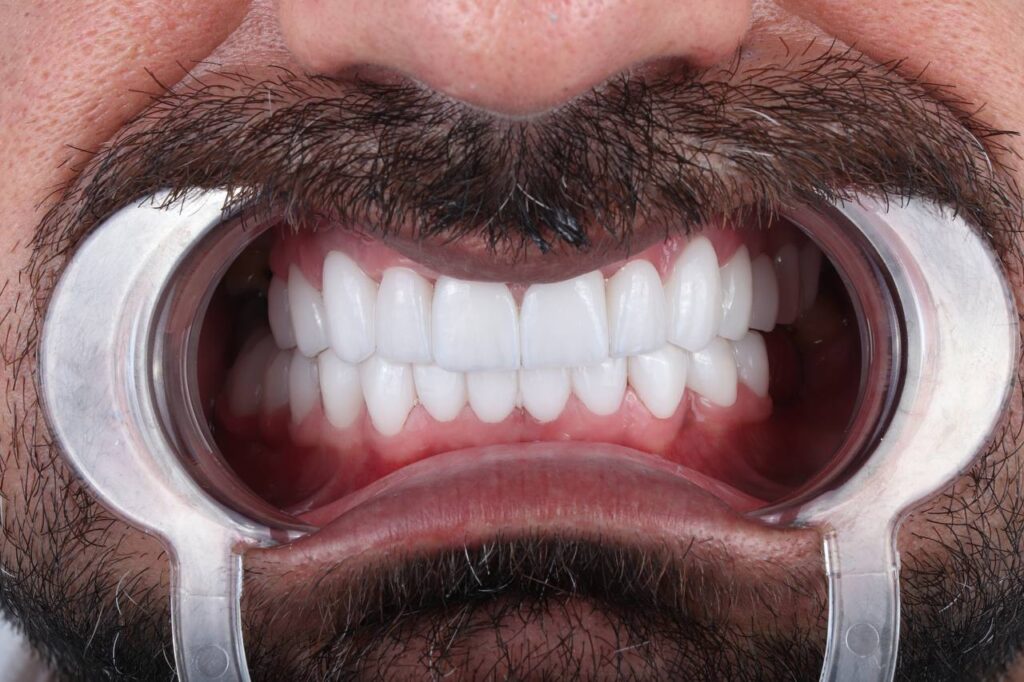Choosing the right prosthetic material is a critical decision in full-arch dental implant restorations (All-on-4, All-on-6). At Marina Clinic, our goal is to help you understand the differences between zirconia, PFM (porcelain-fused-to-metal), and acrylic prosthetics—so you can make an informed choice that balances aesthetics, durability, comfort, and cost.
What Is All‑on‑X and Why Prosthetic Choice Matters
- All-on‑X (All-on-4 / All-on-6) refers to anchoring a full-arch dental prosthesis on 4 or 6 implants.
- The prosthetic superstructure (what you see and chew with) dictates esthetics, strength, hygiene, wear, and long-term performance.
- A literature-backed trend is the increasing preference for metal-free, high-strength ceramics, especially zirconia, in full-arch prosthetics.
Request pricing
By sending, you agree we may contact you on WhatsApp with pricing.
Got it! We’ll WhatsApp you the pricing shortly.
Zirconia Prosthetics — The Premium, Metal-Free Option
Advantages
- High Strength & Fracture Resistance
Modern monolithic zirconia can withstand high occlusal forces with minimal risk of chipping. - Natural Aesthetics & Translucency
Zirconia’s optical properties allow a close match to natural teeth without requiring a metal substructure. - Biocompatibility & Gum-Friendly
Being metal-free, it avoids metal allergies and reduces risk of soft‑tissue irritation. - No Dark Lines at the Gumline
Unlike PFM, there’s no risk of a gray margin showing if gums recede.

Disadvantages / Considerations
- Higher Cost
The material and fabrication (CAD/CAM milling, sintering) drive a higher price. - Repair Complexity
If damaged, zirconia is harder to repair (often requiring full replacement of the segment). - Potential for Opposing Tooth Wear
Without careful polishing and design, the hardness of zirconia might contribute to wear on opposing teeth.
Ideal Use Cases
- Patients prioritizing long-term durability and premium aesthetics
- Anterior arch or full-arch restorations where gum margins are visible
- Patients with metal sensitivities
Also read : Hollywood Smile in Turkey 2025: Price, Quality & Why It’s a Top Choice
Porcelain-Fused-to-Metal (PFM) Prosthetics — The Time-Honored Choice
Advantages
- Proven Track Record of Durability
PFM restorations have decades of clinical history supporting their longevity. - Strong Metal Support
The metal substructure adds rigidity, especially in high-load zones like the posterior arch. - More Affordable Than Zirconia (Often)
Especially when using base or semi-precious alloys.

Disadvantages / Considerations
- Risk of Metal Margin Visibility
With gum recession over time, the metal edge can show as a dark line. - Porcelain Layer Susceptible to Chipping
The bond between porcelain and metal can suffer under high occlusal stress. - Potential for Metal Allergies or Sensitivities
Some patients may react to certain alloys used in PFM restorations.
Ideal Use Cases
- Restorations in less visible zones (posterior arch) where aesthetics is secondary
- Cases requiring strong support over long spans
- Patients who want a cost-effective balance between strength and appearance
Acrylic Prosthetics — The Cost-Effective and Temporary Solution
Advantages
- Lowest Cost
Acrylic (resin-based) is far more affordable than ceramic solutions. - Lightweight & Easier Adjustment
Easier for patients transitioning to a full-arch prosthesis. - Fast and Easily Repairable
Cracks or adjustments can be addressed quickly during healing phases.
Disadvantages / Considerations
- Limited Durability
Acrylic is prone to wear, fractures, and discoloration over time; often requires replacement every few years. - Inferior Aesthetics
Less translucency, less lifelike in appearance, more susceptible to staining. - Less Ideal for Permanent Use
Best used as temporary or interim prostheses, not long-term definitive solutions.
Ideal Use Cases
- Immediate loading or temporary prosthetic during the healing period
- Patients wanting a lower-cost interim option
- As a fallback in cases where ceramic materials are contraindicated
Comparative Table: Zirconia vs PFM vs Acrylic
| Feature | Zirconia | PFM | Acrylic |
|---|---|---|---|
| Strength & Fracture Resistance | Very high | High (metal core) | Low |
| Aesthetics & Translucency | Excellent, natural | Good, but risk of metal line | Moderate, prone to discoloration |
| Biocompatibility | Metal-free, low allergen risk | Risk for metal-sensitive patients | Variable |
| Repairability | Hard to repair | Moderate (porcelain repair) | Easy |
| Cost (Initial) | Highest | Mid-range | Lowest |
| Long-Term Use | Excellent | Proven | Limited, often intermediate |
| Best Use Scenarios | Definitive full-arch prosthesis, visible zones | Strong long-span cases in non-aesthetic zones | Temporary, budget, transitional |
Which treatment are you interested in?
How to Choose the Right Option for You
When selecting among zirconia, PFM, and acrylic prosthetics for an All-on-X treatment, consider these factors:
- Aesthetic Priorities: Want a natural, seamless smile? Zirconia wins in most visible areas.
- Budget: Acrylic gives short-term affordability; PFM is middle ground; zirconia is premium.
- Functional Demands: Heavy chewers, bruxers, or those needing high-strength material may favor zirconia or PFM.
- Allergies / Sensitivities: If you have metal sensitivities, zirconia is safest.
- Gum Health & Recession Risk: In those with thin biotypes or tendency for recession, metal margins of PFM may become visible.
- Maintenance & Longevity: Zirconia generally offers superior long-term performance with fewer replacements.
Your clinician should explain trade-offs clearly and may even combine materials (e.g. zirconia in front, PFM in back) for a tailored solution.

Why Choose Marina Clinic for Your All‑on‑X Prosthetics
At Marina Clinic, we strive to deliver prosthetic solutions that merge function, beauty, and durability. Here’s what sets us apart:
- In-House Digital Lab: We use advanced CAD/CAM workflows to precisely design and mill zirconia and hybrid prosthetics.
- Material Quality: We source premium zirconia ceramics and trusted PFM materials to ensure strength and biocompatibility.
- Expertise & Experience: Our implant team has broad experience in full-arch protocols, prosthetic design, and patient-focused outcomes.
- Custom Treatment Planning: We evaluate your bite, gum architecture, aesthetic desires, and anatomical factors to guide material choice.
- Transparent Communication: We present clear comparisons, costs, and expected maintenance so you can make a confident decision.
Summary & Recommendation
- Zirconia is becoming the gold standard for definitive full-arch prosthetics due to its combination of strength, aesthetics, and biocompatibility.
- PFM remains a reliable, cost-effective option—especially in non-esthetic zones—but carries risks of visible metal margins and porcelain chipping.
- Acrylic serves best as a temporary or transitional solution due to lower durability.
- The “best” material is highly individual. Your choice should account for budget, aesthetic goals, functional needs, and long-term maintenance.
- At Marina Clinic, we support your decision with diagnostics, simulations, and personalized guidance
Suggested Academic / Official References
- Clinical evaluation of posterior zirconia‑based and porcelain-fused-to-metal crowns
Materials & Methods / Clinical study — evaluates failure, periodontal health, and aesthetics. ScienceDirect - Survival Rate Comparison between Zirconia and PFM Crowns (McGill University summary)
McGill University, Faculty of Dental Medicine & Oral Health Sciences — review / CAT summary of survival rates. McGill University - Evaluation of the surgical and prosthetic success of All‑on‑4 immediate restorations
Journal of Implant Dentistry — retrospective study comparing provisional vs definitive restorations in All‑on‑4. SpringerOp - Assessment of implant success rates in the All‑on‑X treatment concept
Journal of Oral and Maxillofacial Surgery — outcomes and comparison across All‑on‑X prosthetic designs. joms.org - A new full digital workflow for fixed prosthetic rehabilitation (All‑on‑4 concept)
MDPI / Open Access — case series showing digital planning, CAD/CAM, and prosthetic guide integration. mdpi.com - Comparison of clinical outcomes between zirconia and metal‑ceramic crowns
University of Toronto predoctoral clinic study — 7‑year retrospective outcomes. thejpd.org






